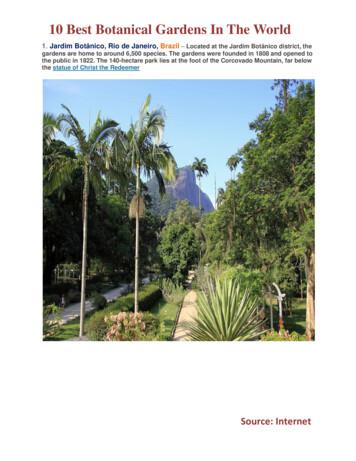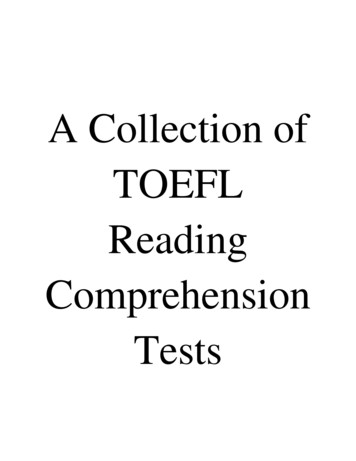A BOTANICAL BEQUEST - Australian National Botanic Gardens
A BOTANICAL BEQUESTLeaving a lasting legacy toAustralia’s national garden
Message from the Executive DirectorIn 1945, noted Australian botanist, Lindsay Pryor received 1,000 to start work on what would become the AustralianNational Botanic Gardens and the transformation of BlackMountain farm land into ‘Australia’s garden’ began.Reflecting on these modest beginnings,I’m always struck by how much has beenachieved during the preceding years.The commitment of governments, botanists,horticulturalists and the community for just over halfa century has made the Gardens a leading scientificinstitution with the world’s most comprehensivecollection of Australian plants, as well as anenduring and much‑loved national attraction.The generosity of many individuals has also beenvital to this success. Bequests from people wishingto leave a legacy to a place they loved and for workthey valued, will help us to enhance the Gardens.As we look to the next half century and ourmany exciting plans for the Gardens’ future, weinvite you to consider making a bequest to theAustralian National Botanic Gardens – helpingus in our mission to inspire, inform and connectpeople to Australia’s amazing and diverse flora.Dr Judy WestExecutive Director
About the Australian National Botanic GardensA living collection like no otherThe Australian National Botanic Gardens is the world’smost comprehensive display of living Australiannative plants. With over 6,000 species representingone-third of known Australian plants, the Gardensis the only place in the world you can see thisdiversity of Australian native plants in one location.Spaning 40 hectares of water-wise, sustainablymanaged gardens, the Australian National BotanicGardens’ collection includes over 70,000 plants.Collected over the last five decades, the plantsrange from coastal regions, alpine meadows,tropical rainforests to dry deserts.A world-leader in researchThe Australian National Botanic Gardens hasa strong international reputation for scientificand horticultural research and often workscollaboratively with leading institutions.The Australian National Botanic Gardens’ partnershipwith CSIRO at the Centre for Australian NationalBiodiversity Research, for example, fosters vitalwork that enhances knowledge, conservationand sustainable use of Australian flora.The Centre houses the Australian National Herbarium,a leading research institution for the naming andclassification of Australian plants, which holdsa collection of over 1.4 million specimens.The Australian National Botanic Gardens alsoplays an important role as part of the nationalbiodiversity safety net through our Seed Bank.An inspiring placeFrom cleared dairy farms at the foot of BlackMountain to a much-loved national institution, theAustralian National Botanic Gardens welcomesclose to half a million people from across thenation and around the world every year.Of these visitors, more than 12,000 studentsthroughout Australia come to take partin environmental education programs,fostering an understanding and anappreciation for Australia’s native flora.ManagementThe Gardens are managed by the Director ofNational Parks – a Commonwealth StatutoryAgency established to manage Commonwealthreserves such as the Australian NationalBotanic Gardens. The Director of NationalParks is governed in accordance with theCommonwealth Authorities and CompaniesAct 1997 and relevant government policies.
What is a bequest?A bequest is a gift made through a Will. It is away to give tangible support to what you valueand to leave a lasting legacy in your memory.A bequest helps us to realise the long-termvision for the Gardens, enabling us to: expand the living collection bydeveloping new gardens engage in new research projects increase our conservation efforts share our knowledge more effectively deliver new education and public programsWe direct bequests to where they willprovide the most benefit, but you may wishto nominate a specific purpose for yourbequest. If so, we encourage you to contactthe Australian National Botanic GardensGeneral Manager for a confidential discussionabout your preferences and ideas.Importantly, the Australian National BotanicGardens manages and accounts for allproceeds of bequests, in accordance withCommonwealth Government guidelines,ensuring that funds are directed to thepurpose for which they were provided.The Ducrou PavilionThe Ducrou Pavilion on theEucalypt Lawn was madepossible through a generousbequest from Anne Ducrou.The Pavilion features aseries of roofs supported bycolumns of abstract ‘trees’,which help reinforce theimportance of real trees tothe Gardens’ landscape.Opened in 1999, the pavilioncontinues to be a popularvenue for picnics and is oftenused for special events.
Types of bequestsBequests can take many forms and we recommend thatif you’re considering making a gift in your Will, youseek independent legal and financial advice. This willensure that the type of gift suits your circumstances and,importantly, considers your family and those close to you.Bequests can be on any scale and may involve: a sum of money from your estate a percentage of your estate a specific asset, such as shares and lifeinsurance or other possessions includingdocuments and academic papers a residue of your estate after family and friendshave received their gifts and provision hasbeen made for all duties, debts, probate andtestamentary expenses from your estate.
Making a bequestThe following draft clauses are intended only as a guide, forthe reference of your solicitor, and we encourage you to seekindependent legal advice in preparing or amending your Will.Should you or your solicitor have any queriesabout making a bequest to the AustralianNational Botanic Gardens, please contactthe General Manager on (02) 6250 9500.Draft wording for a specific bequestDraft wording for anunrestricted bequestSpecify eitherI give the Director of National Parks trading asthe Australian National Botanic Gardens,GPO Box 1777, Canberra, ACT, 2601Specify eithera.b.c.d.the sum of cash;shares, property, other assets or possessions;the percentage of the estate; orthe percentage of the residue of the estatefree of all duties, debts, probate and testamentaryexpenses, to support the activities of the AustralianNational Botanic Gardens. I direct that the receiptof the Executive Director of the Australian NationalBotanic Gardens or their delegate shall be full andsufficient discharge to my Executor or Trustee.I give the Director of National Parks trading asthe Australian National Botanic Gardens,GPO Box 1777, Canberra, ACT, 2601a.b.c.d.the sum of cash;shares, property, or other assets;the percentage of the estate; orthe percentage of the residue of the estate]free of all duties, debts, probate andtestamentary expenses, to be used for[describe details of specific purpose]If that purpose is not available for whateverreason, I request that my gift be applied in asimilar field or for such other purposes as theAustralian National Botanic Gardens determines inits sole discretion are most closely in accordancewith my directions. I direct that the receipt of theExecutive Director of the Australian NationalBotanic Gardens or their delegate shall be full andsufficient discharge to my Executor or Trustee.
Please let us know so we can thank youShould you decide to include the AustralianNational Botanic Gardens in your Will, wewould like to thank you personally and to inviteyou to events and functions at the Gardensthat align with your areas of interest.Please note that unless you specifically allow usto do so, we maintain strict confidence and donot disclose the names of any of our bequestors.To help us get to know you, please: phone the General Manager (02) 6250 9500; advise the General Manager in writing atthe Australian National Botanic Gardens,GPO Box 1777, Canberra, ACT, 2601; or send an email to anbg-info@anbg.gov.au
www.anbg.gov.au
managed gardens, the Australian National Botanic Gardens' collection includes over 70,000 plants. Collected over the last five decades, the plants range from coastal regions, alpine meadows, tropical rainforests to dry deserts. A world-leader in research The Australian National Botanic Gardens has a strong international reputation for scientific
US 10,000 — One-Diamond Pin plus Bequest Society Crystal Two: US 25,000 — Two-Diamond Pin plus Bequest Society Crystal Three: US 50,000 — Three-Diamond Pin plus Bequest Society Crystal Four: US 100,000 — Four-Diamond Pin plus Bequest Society Crystal Five: US 500,000 — Five-Diamond Pin plus Bequest Society Crystal Six: US 1,000,000 —
10 Best Botanical Gardens In The World Source: Internet 4. Berlin-Dahlem Botanical Garden and Botanical Museum, Berlin, Germany - Opened to the public in 1910, this botanical garden has an area of 43 hectares and 22,000 plant hespecies. The garden is part of the Free University of Berlin and t Botanical Museum is attached to the garden
HISTORIC The New York Botanical Gardens AND/OR COMMON The New York Botanical Gardens LOCATION CITY. TOWN -VICINITY OF New York COUNTY Bronx STATE New York PHOTO REFERENCE PHOTO CREDIT NEGATIVE FILED AT The New York Botanical Gardens The New York Botanical Gardens DATE OF PHOTO circa 1962; confirmed 1975 IDENTIFICATION DESCRIBE VIEW. DIRECTION. ETC.
Australian Patent No. 692929 Australian Patent No. 708311 Australian Patent No. 709987 Australian Patent No. 710420 Australian Patent No. 711699 Australian Patent No. 712238 Australian Patent No. 728154 Australian Patent No. 731197 PATENTED NO. EP0752134 PATENTED NO.
Missouri Botanical Garden Right in the middle of St. Louis, Missouri is one of the nation's oldest botanical gardens. Founded in 1859, this 79-acre horticultural display, which attracts over 800,000 visitors each year, is now also a National Historic Landmark. The pri-vately administered Missouri Botanical Garden (MBG) was established as the
Botanical name of Ceylon cinnamon Botanical names for plants were developed to identify individual plants scientifically because there were many different common names given to one particular plant. It is also reliable to identify a plant by its botanical name, rather than by its common name. Sometimes there can be
Botanical gardens have traditionally been landscapes of learning. Whether through passive or active opportunities, visitors to botanical gardens expect to be presented with new information, new sights and new experiences. When combined with the large scale of botanical gardens, their traditional role as educational landscapes puts them
3 PRACTICE TEST 01 May 2004 Question 1-10 All mammals feed their young. Beluga whale mothers, for example, nurse their calves for some twenty months, until they are about to give birth again and their young are able to























